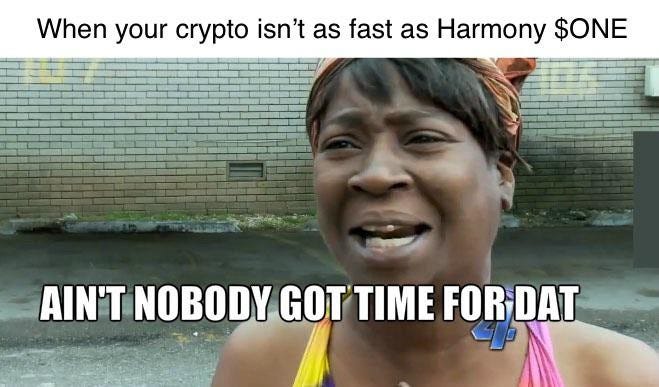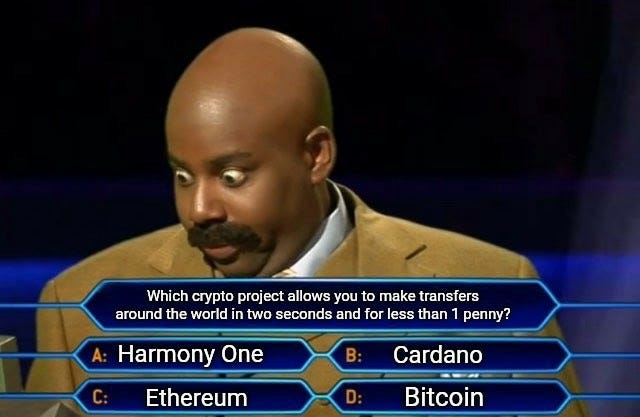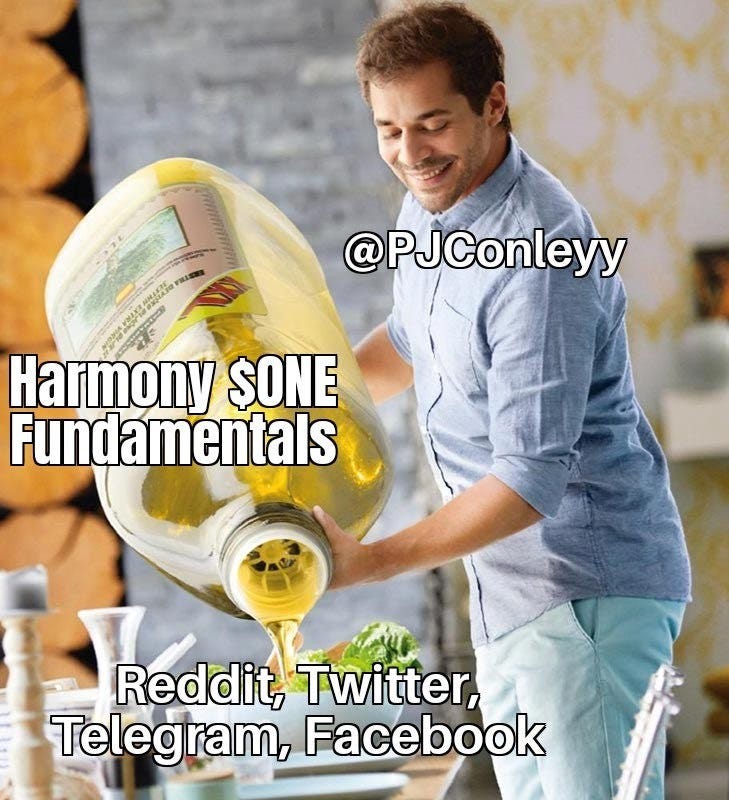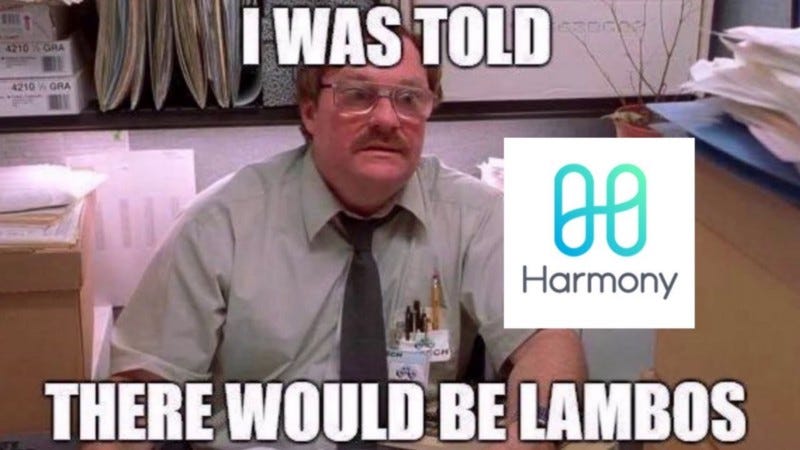For $ONE and For All: Harmony Ecosystem Overview
Harmony is a blockchain platform that is designed to facilitate the creation and use of dApps on the Ethereum network.
Issues with ETH
Bitcoin will always remain in history books as the first-ever mass application of blockchain technology. The Bitcoin Whitepaper introduced a decentralized money system that cut off intermediaries. However, it was not until Ethereum was launched in 2015 that people learned this technology has applications outside of finance. The introduction of smart contracts was seen as a game-changer as transactions were faster, cheaper, and cut off intermediaries. However, Ethereum still has some challenges such as:
Energy consumption. Ethereum blockchain uses ‘Proof of Work’ as the consensus mechanism. Computers consume a lot of energy as they try to solve different cryptographic puzzles on the network.
Scalability. Ethereum protocol can only handle 15 transactions per second. Even though it is faster than Bitcoin, traditional payment platforms like VISA handle around 1,700 transactions per second.
What is Harmony
There are many blockchains focusing on bringing users to DeFi and Harmony happens to be amongst the leaders. Harmony is a blockchain platform that is designed to facilitate the creation and use of dApps (decentralized applications) on the Ethereum network while utilizing interoperable services.
Harmony seeks to provide an avenue for creating marketplaces for both non-fungible and fungible tokens while following an avenue of data sharing that focuses on user privacy.
Brief History
Stephen Tse founded Harmony in 2018, but the protocol became live in 2019. Stephen Tse is an experienced engineer in cryptographic protocols, and his aim was to provide a decentralized, open and trustless blockchain platform for DeFi users globally. Tse involved 20 other members in creating the project, whose experience was diverse in areas such as machine learning, software development, artificial intelligence, blockchain technology and virtual reality.
The team held consistent meetups in San Francisco, and with time the project started to gain the interest of multiple investors. Harmony raised over $18 million in funding during its fundraising round in 2019. The project has been continuously growing both online and offline communities and accommodating new users since its launch.
Technology
Harmony has some unique features that seek to address challenges that face other blockchain protocols. This platform features a deep sharding system, a consensus protocol, a Distributed Randomness Generation (DRG), and cross-chain interoperability.
Sharding
Sharding refers to the process of splitting a blockchain network into smaller partitions, known as shards, in a bid to increase latency across the network. Sharding was introduced to address the scalability problem faced by the Ethereum network. A number of blockchain protocols have sought to address this issue, but most have proven to be of little or no help.
Harmony has addressed the common issues of sharding, and the powered sharding is responsible for the 2-second transaction finality on this blockchain. The platform’s transaction fees are 100 times lower than other blockchains. There is shard 0, shard 1, shard 2, and shard 3 that support 250 validators each.
FBFT Consensus
Fast Byzantine Fault Tolerance, abbreviated as FBFT Consensus, is responsible for simplifying communication processes on the platform. Under this model, the appointment of validators is determined by the number of tokens possessed. This model eliminates the need for a vote broadcast as an increase in the number of tokens owned automatically increases the chances of being picked as a validator. FBFT consensus employs a simple multi-signature design and process.
Distributed Randomness Generation
Abbreviated as DRG, Distributed Randomness Generation is a random-based sharding mechanism that uses verified random numbers to appoint sharding assignments for every node on the network.
Cross-Shard Communication
Cross-shard communication is a tech feature that reduces the degree and number of complexities that emerge while running the communication protocol on the platform. Kademlia is a distributed hash table and routing protocol that the system relies on. The concept facilitates the communication system within shards as it enables nodes within a shard to receive and send information within themselves through a shard ID. The approach eliminates the need to broadcast information across other shards.
Ethereum’s Integration
High gas fees on the Ethereum network has made many developers shelve the idea of developing dApps within the ecosystem. Ethereum’s growth is slowing down as users start to focus on other alternatives where gas fees are significantly lower.
Ethereum’s low scalability capacity has made it hard to support the creation and deployment of decentralized apps. Harmony’s unique functionality seeks to address the challenges that the Ethereum network faces. The scalable next-generation sharding-based protocol on Harmony curtails the limitations of Ethereum. Harmony provides an energy-efficient and secure platform that is hosted on the Ethereum network and still supports decentralized apps.
Harmony Token ($ONE)
$ONE token, whose name is derived from the platform’s vision “For One and For all” is Harmony’s native token. $ONE governs various activities on the platform such as:
Voting for on-chain governance of the protocol.
Pay for gas, transaction fees, and storage fees.
Used for staking which must be there for POS consensus where validators earn block rewards and transaction fees.
The token incentivizes and rewards various participants such as investors, validators and stakers, developers and community members who are involved in the development and governance of the network.
Validators can easily join the protocol as they just need to stake a minimum of 10,000 $ONE tokens. The validators will then receive rewards depending on the portion of $ONE tokens they staked. Those who double sign aiming to manipulate the system are punished by slashing a large portion of their stake and eventually being eliminated from the system.
The fact that all $ONE tokens earned through transaction fees are burnt is what sets Harmony apart from other Layer 1s. Zero token inflation is brought about by high network usage. The mechanism of issue-and-burn tokenomics that rewards a growing network by reducing inflation ultimately increases the intrinsic value of $ONE token.
The current staking ratio assures delegated tokens earnings of about 10% after fees. Such returns are in the mid-range of staking returns when compared with competing L1s. About 42% of $ONE tokens are currently staked based on the fact that there are consistent returns and predictable inflation that declines with increase in network usage.
Harmony Foundation Fund
Harmony recently unveiled a $300M ecosystem fund to back startups working on various protocols and decentralized applications. Stephen Tse was quoted saying that Harmony was purposely built to help developers who built on it to easily bridge to other blockchains. The idea was to make interoperability between chains seamless and affordable.
The official website has highlighted how the fund will be deployed in the next few years. The aim is to roll out $180M by the 3rd quarter of 2022. The breakdown is as follows:
$50 million will fund 100 DAOs
$30 million will fund 1000 bounties
$30 million for 10 partnerships
$10 million for 10 hackathons








